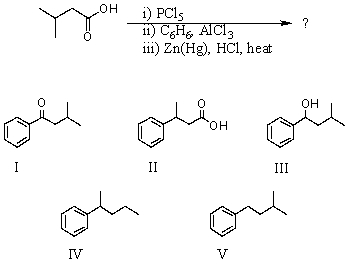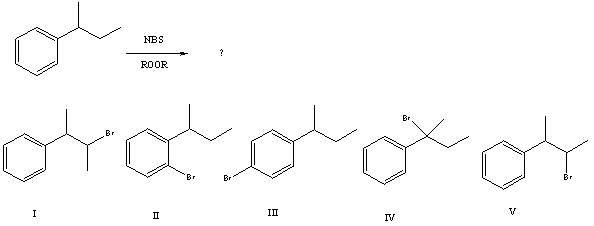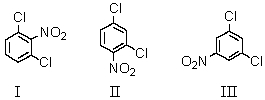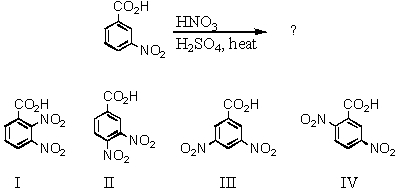A) Cl2,light,and heat
B) Cl2,FeCl3
C) SOCl2
D) C2H5Cl,AlCl3
E) None of these choices.
G) A) and E)
Correct Answer

verified
Correct Answer
verified
Essay
Based on your knowledge of electrophilic aromatic substitution,predict the preferential position of attack of an electrophile on furan,i.e.,does the electrophile E+ attack carbon 2,or 3? Explain your answer.  Which substitution product forms preferentially and why?
Which substitution product forms preferentially and why?
Correct Answer

verified
The 2 substitution product is favored si...View Answer
Show Answer
Correct Answer
verified
View Answer
Multiple Choice
Which of the following compounds would be most reactive toward electrophilic substitution? 
A) I
B) II
C) III
D) IV
E) V
G) A) and E)
Correct Answer

verified
Correct Answer
verified
Multiple Choice
What would be the product of the following reaction sequence? 
A) I
B) II
C) III
D) IV
E) V
G) C) and E)
Correct Answer

verified
Correct Answer
verified
Multiple Choice
(Trifluoromethyl) benzene,C6H5CF3,will
A) nitrate rapidly in the ortho-para positions.
B) nitrate slowly in the ortho-para positions.
C) nitrate rapidly in the meta position.
D) nitrate slowly in the meta position.
E) fail to nitrate under any conditions.
G) B) and C)
Correct Answer

verified
Correct Answer
verified
Multiple Choice
The compound 4-bromo-1-propylbenzene is best made from benzene by the application of these reagents in the order shown:
A) (1) Br2,Fe (2) CH3CH2CH2Cl,AlCl3
B) (1) CH3CH2CH2Cl,AlCl3 (2) Br2,Fe
C) ![]()
D) ![]()
E) (1) (CH3) 2CHCl,AlCl3 (2) Br2,Fe
G) None of the above
Correct Answer

verified
Correct Answer
verified
Multiple Choice
What would be the major product of the following reaction? 
A) I
B) II
C) III
D) IV
E) V
G) A) and C)
Correct Answer

verified
Correct Answer
verified
Multiple Choice
Which is the best sequence of reactions for the following transformation? 
A) i) SOCl2; ii) C6H6,AlCl3; iii) Zn(Hg) ,HCl; iv) HNO3,H2SO4
B) i) SOCl2; ii) HNO3,H2SO4; iii) C6H6,AlCl3; iv) H2,Ni
C) i) HNO3,H2SO4; ii) SOCl2; iii) C6H6,AlCl3; iv) Zn(Hg) ,HCl
D) i) PBr3; ii) HNO3,H2SO4; iii) C6H6,AlCl3; iv) NaBH4,H2O
E) Two of these syntheses are satisfactory.
G) A) and B)
Correct Answer

verified
Correct Answer
verified
Multiple Choice
What would you expect to be the major product(s) obtained from the mononitration of m-dichlorobenzene? 
A) I
B) II
C) III
D) Equal amounts of I and II.
E) Equal amounts of I,II and III.
G) B) and C)
Correct Answer

verified
Correct Answer
verified
Multiple Choice
Which of the following contributors to the resonance stabilized hybrid formed when aniline undergoes para-chlorination would be exceptionally stable? 
A) I
B) II
C) III
D) IV
E) None of these choices.
G) B) and D)
Correct Answer

verified
Correct Answer
verified
Multiple Choice
What is the Birch reduction product of the following reaction? 
A) I
B) II
C) III
D) IV
E) V
G) A) and E)
Correct Answer

verified
Correct Answer
verified
Multiple Choice
A mixture of chlorobenzene (1 mol) and anisole (1mol) is allowed to react with Br2 (0.5 mol) in the presence of trace amounts of FeBr3.What is the principal product of the competing reactions?
A) 1-bromo-4-chlorobenzene
B) 1-bromo-2-chlorobenzene
C) 1-bromo-3-chlorobenzene
D) 4-bromoanisole
E) 3-bromoanisole
G) B) and C)
Correct Answer

verified
Correct Answer
verified
Multiple Choice
Benzoic acid can be prepared by the oxidation of which of the following compounds:
A) C6H5CH=CH2
B) C6H5C CH
C) C6H5COCH3
D) C6H5CH2CH2CH3
E) All of these choices.
G) A) and B)
Correct Answer

verified
Correct Answer
verified
Essay
When the following substance is treated with Br2/FeBr3,the major product is obtained in good yield,and only very small amounts of minor products are found.What is this major product and why are the minor products not formed to any significant degree? Explain clearly. 
Correct Answer

verified
The major products are produced by bromi...View Answer
Show Answer
Correct Answer
verified
View Answer
Multiple Choice
Arrange the following compounds in order of decreasing reactivity in electrophilic substitution: 
A) V > II > I > III > IV
B) II > V > III > I > IV
C) IV > I > III > V > II
D) III > II > I > IV > V
E) IV > V > II > I > III
G) D) and E)
Correct Answer

verified
Correct Answer
verified
Multiple Choice
Which reagent(s) would you use to synthesize 2- and 4-bromo-1-cyclopentylbenzene from cyclopentylbenzene?
A) N-Bromosuccinimide (NBS) ,CCl4,light
B) PBr3
C) Br2,FeBr3
D) CH3CH2Br,AlBr3
E) HBr,ROOR
G) All of the above
Correct Answer

verified
Correct Answer
verified
Multiple Choice
What would be the major product(s) of the following reaction? 
A) I
B) II
C) III
D) IV
E) Approximately equal amounts of II and IV.
G) All of the above
Correct Answer

verified
Correct Answer
verified
Multiple Choice
The reaction of benzene with  in the presence of anhydrous aluminum chloride produces principally which of these?
in the presence of anhydrous aluminum chloride produces principally which of these? 
A) I
B) II
C) III
D) IV
E) V
G) C) and D)
Correct Answer

verified
Correct Answer
verified
Multiple Choice
Which would be the major product(s) of the following reaction? 
A) I
B) II
C) III
D) I and II in roughly equal amounts.
E) I and III in roughly equal amounts.
G) B) and D)
Correct Answer

verified
Correct Answer
verified
Multiple Choice
Which of these is a satisfactory synthesis of 1-bromo-2-phenylethane?
A) C6H5CH2CH3 + Br2,Fe3+
B) C6H5CH2CH3 + Br2,400 C
C) C6H5CH2CH2OH + Br2,CCl4
D) C6H5CH=CH2 + HBr,ROOR
E) C6H5CH2CH3 + NBS,ROOR
G) None of the above
Correct Answer

verified
Correct Answer
verified
Showing 121 - 140 of 207
Related Exams